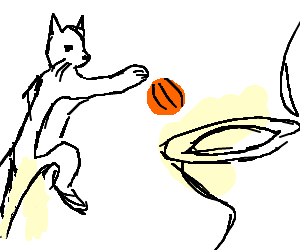
I think we all know where last night’s dunk challenge belongs.
What’s He Got on You? Only Rank.
Seth Partnow
Where Offense Happens
In this piece, Seth Partnow accomplishes two tricky tasks. He not only explains why Harrison Barnes has been such a disappointment for the Golden State Warriors this season as a primary scorer off the bench, but also why Draymond Green has been such a boon as a versatile defender and facilitator. He also advances some interesting arguments as to why Mark Jackson is choosing to play Barnes over Green in many situations. Interestingly, though much of the evidence is rooted in advanced statistics, Partnow asserts that Jackson prefers Barnes over Green because Barnes looks like he should be a versatile cog in the machine, but his slow release, flat-footedness, and tentativeness belies this perception. I love both of these guys, but Partnow is absolutely correct: Green has been the much better player this season.
Secret History of the First Dunk
Evin Demirel
The Daily Beast
A few months ago, I attempted to explain the significance of the dunk to the modern fan of the NBA. I wish Evin Demirel had written this excellent piece before I tried to unpack the dunk, as it would’ve been a great asset. Demirel expertly accesses primary and secondary sources to write a short history of the dunk, including the birth of the name, and how it became a standard part of the game. Demirel’s account of the rise of the dunk fits in beautifully with his description of a vastly different game, where a slick ball operated like “bulky pumpkin,” and a cage of chicken wire was used to facilitate the first alley-oop. This is a really fun, informative piece, and Demirel did a fantastic job creating a tidy narrative that is as engaging as it is informative. Very nice work from Demirel and The Daily Beast.
Big Man, Little Man
Jonathan Abrams
Grantland
It’s Abrams. It’s long-form. It’s players you don’t really think about too often, among the pantheon of well-treaded NBA rags-to-riches stories. What more do I need to say? Abrams’ latest opus focuses on Jared Sullinger and Trey Burke, two young rotation players for rebuilding teams, who share a history that dates back generations. Abrams is able to work with themes that he often incorporates into his pieces, including growing up in midwestern cities, father-son relationships, failed expectations and the importance luck and opportunity have in creating prep-to-pro legends. It’s amazing that Abrams can take stories that, on the surface, seem to resemble one another, and provide just the right about of dialogue and texture to differentiate the tales. This is another worthy entry into his own impressive corpus of works.
Down in Frequency, ACL Numbers were Never Abnormal to Start
Sean Deveney
Sporting News
There are probably no three letters that strike more fear into the hearts of sports fans than “ACL.” While it is far from a fatal blow to an athlete, an ACL tear typically means an emotional, traumatic injury, lengthy lay-off, intensive rehab, and few guarantees about a return to form, and a guarantee against re-injury. For a time, it seemed like there was a rise in ACL injuries in the NBA, especially after the 2011 lockout. Sean Deveney provides some additional commentary to this assertion, and provides us with some interesting information into research around ACL injury prevention in the NBA. He notes that while there was a small spike in ACL injuries after the 2011 lockout, they weren’t abnormal from the standard number of injuries in previous seasons. Deveney attributes this perception to the fact that Derrick Rose, 2010 MVP, suffered the injury, and his rehab remained in the public consciousness for over a year. He also adds that increased education around preventing NBA injuries has not only caused a drop in injuries (this season has only seen once ACL tear; to the Denver Nuggets’ Nate Robinson), but has also saved NBA owners money. Last season, NBA owners lost $50 million in salary due to ACL injuries; a staggering number. Hopefully the day comes that the injury can be totally prevented, but until that happens, it’s nice to know that teams and doctors are working together to reduce the chance of injuring the ligament in the first place.
From the Elbow: On Jason Williams’ Greatest Pass
Ian Levy
The Classical
My inner history buff loved this piece by Ian Levy, which focuses on Jason Williams’ famous elbow pass from the Rookie-Sophomore Challenge in Oakland in 2000. The piece uses the rise of modernism and modernity as a motif, and contextualizes the pass, the player, and his team within that tradition. Levy seamlessly weaves the event into this narrative, showing how a confluence of specific trends — the rise of wall-to-wall coverage, the end of the Jordan era, and a changing perception on what constituted “modern” basketball — led to this specific moment for Williams, and the lasting affects its had on our consciousnesses. This is a next-level sort of piece that requires a bit of close reading to fully understand. I’d expect nothing less from Mr. Levy, one of the most skilled writers in the basketblogosphere.

